
Higher prices for fish and lower fuel prices have given the fishing industry a boost in recent years. Simrad in Spain, where the department in Villajoyosa recently took over a new 3,000-square meter premises, has noticed this.
-
Text:OVE RONNY HARALDSEN
Photo:OVE RONNY HARALDSEN
-
Ove Ronny HaraldsenGroup Communication Manager
“We’ve doubled our turnover in the last five years”, says Agustin Mayans Fernandez, managing director of Simrad’s business in Villajoyosa.
Villajoyosa is situated about a 30-minute drive north of Alicante on the Spanish Mediterranean coast. The department was established in 1995, and according to Agustin they ended up here because there were good links with Norway.
Torrevieja, the Norwegian colony in Spain where over 20,000 Norwegians live, is not far from here. So is the Norwegian community in Alfás del Pí.
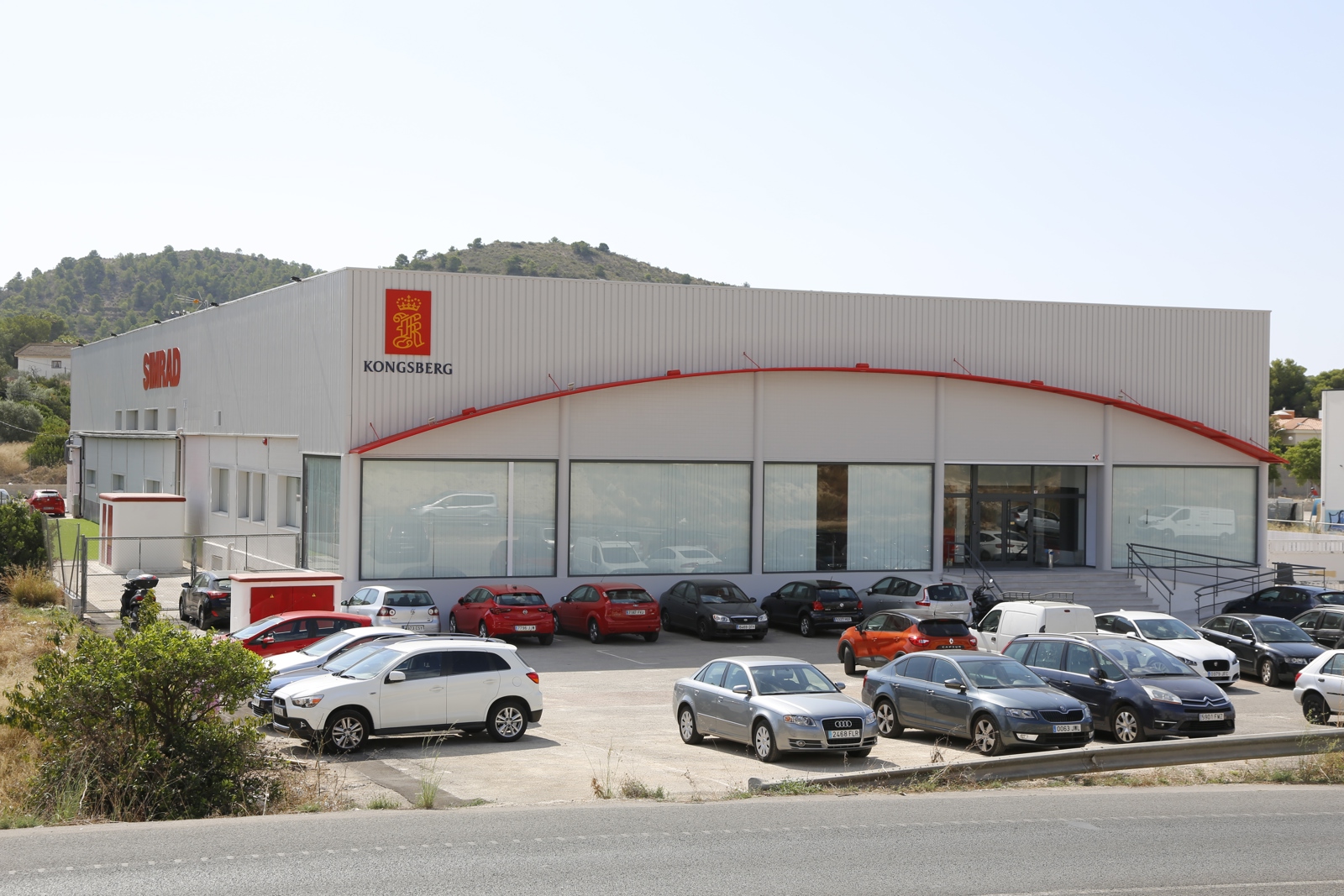
The Simrad department in Villajoyosa currently has 63 employees who recently moved into a new, specially-adapted building. From here Simrad is targeting markets in Spain, Portugal, France, Italy, Russia and Africa. Simrad’s head office in Spain is here in Villajoyosa, with sub-offices in France, Vigo and Las Palmas.
FISHING AND RESEARCH
- About half of our business is fishing. The other half comes from sales of subsea equipment in combination with fisheries research systems installed on advanced research vessels. This is a type of ship that Spanish shipyards have been specialized in the recent years, says Agustin Mayan Fernandez.
Simrad in Spain is subject to the Subsea Division in Kongsberg Maritime. This means that the department in Spain is part of the supply chain for Kongsberg Maritime. In recent years, Simrad in Spain has been co-operating, among other projects, on the Norwegian research vessel Fridtjof Nansen and the Argentine research vessel Victor Angelescu.
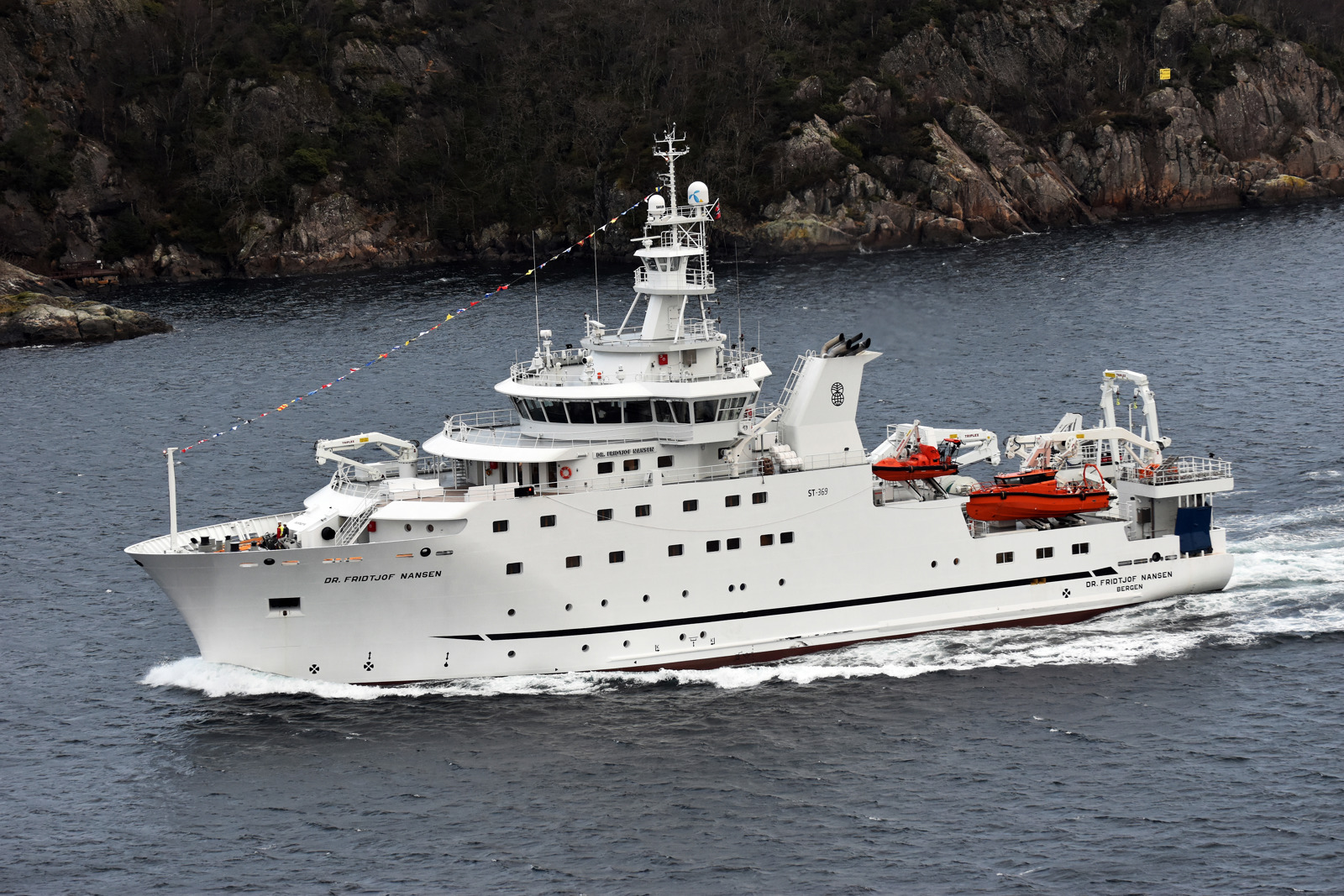
“We sell the full range of echo sounders and sonars. From small single echo sounders that look straight down into the water to the more complex multibeam echo sounders that can see fish from a long way off. We also sell echo sounders that survey sediment on the seabed, and we’ve sold bigger systems like the HUGIN underwater vehicle”, says Agustin Mayans Fernandez.
SALES AND PRODUCTION
Agustin takes us around the facilities at the new building in Villajoyosa. Beyond the reception, there is a large open-plan space where sales and customer support is located. The stairs up to the first floor lead to the software department where developers work on the software for echo sounders, etc. There are modern meeting rooms and chill-out areas with nice designs, modern lines and extensive use of the Simrad logo colour.
Towards the rear of the building, we go through a storage area and arrive at the place where Simrad will test and quality assure the equipment they supply. There are going to be water tanks and other test facilities like those at Simrad’s Norwegian head office in Horten. Another area is dedicated to production, and according to Agustin the production department will be increasing.
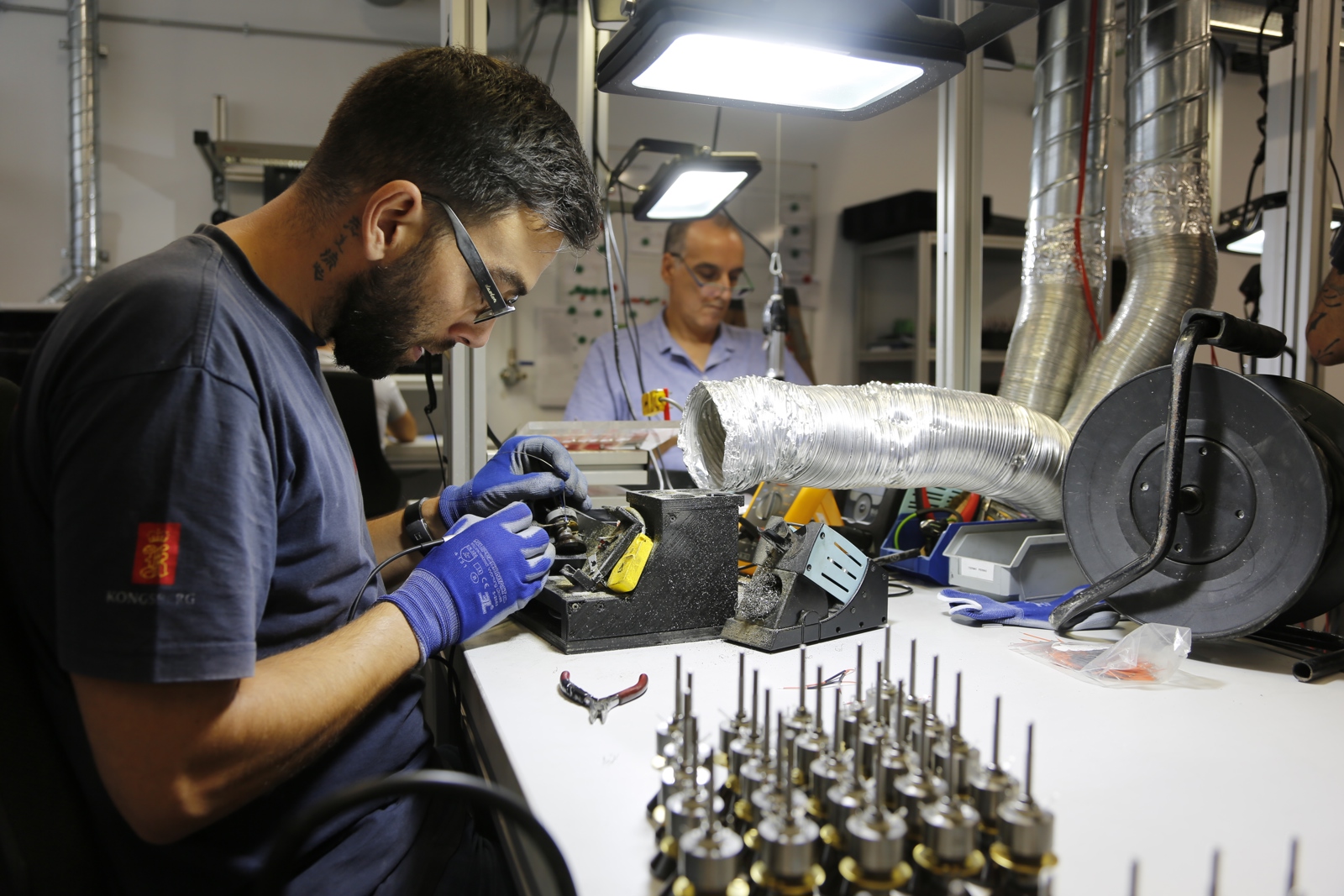
“Since 2013, Simrad has been moving parts of its production from Horten to Spain. Some of the production of HIPAP (High Performance Acoustic Positioning) is currently being carried out in Spain, and now parts of the production of CNode transponders will also be moved to the premises in Villajoyosa.
RESEARCH INTO POLYMERS
In this area, we also meet Celia Guillem and Emmanuel Fernández who are dressed in white research coats. We go into the polymer lab where they are working on finding the most suitable material for Simrad’s characteristic trawl sensors. This equipment sits snugly in the trawl net under the water and tells the fishermen how the trawl net is behaving and what is in it.
When K-magazine was visiting the lab, they were about to develop a material that is sturdier than before and more shock-resistant.
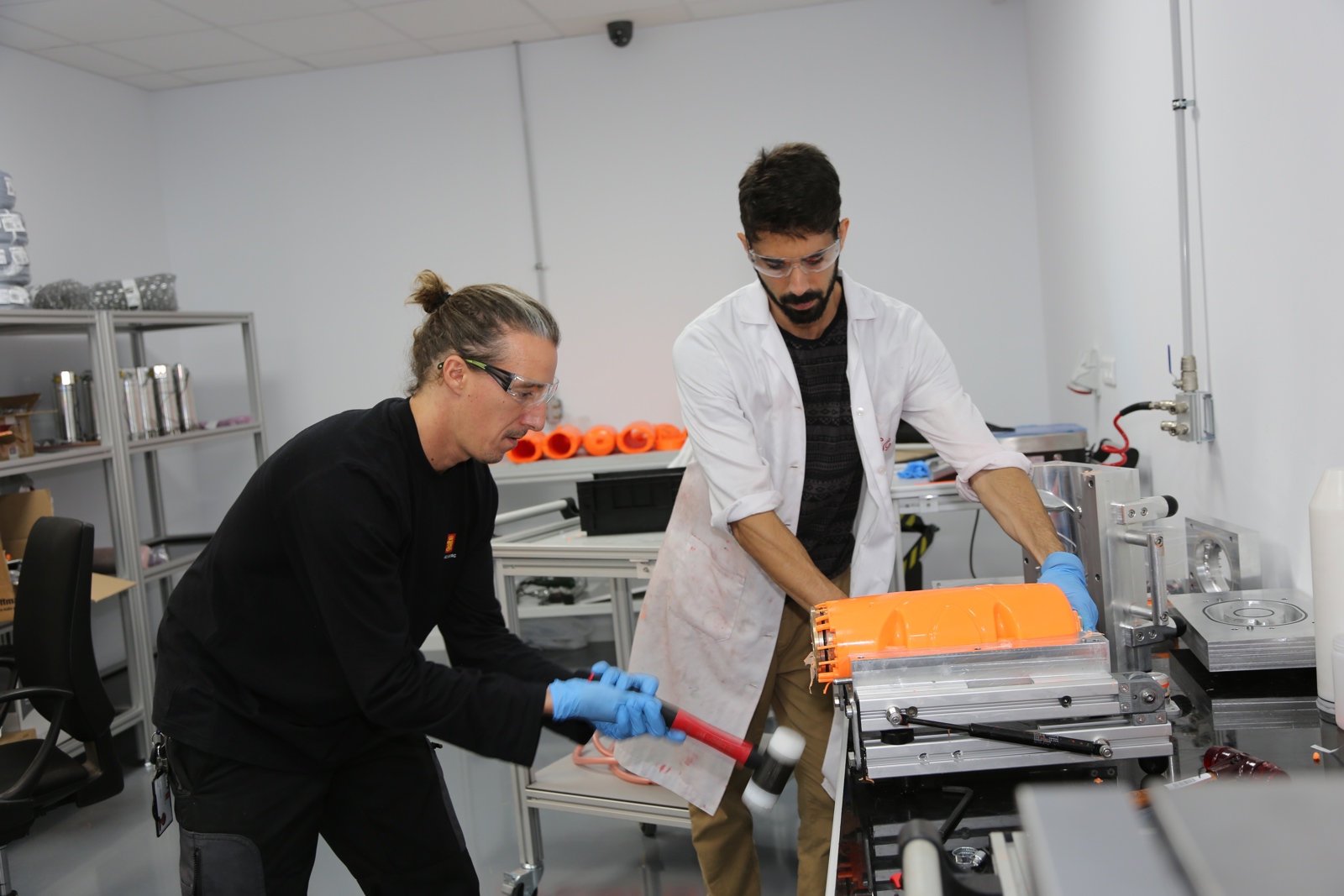
“It was challenging because there were small air bubbles when the last cast was taken out of the form”, says Celia.
A few strong blows with a rubber hammer and the sides of the form loosened. The surface seems to be perfect.
“We’re benefiting from the big polymer industry here in this region. There are also lots of universities in the area producing well-qualified people”, Agustin explains as he rattles off a number of advantages of being based in Villajoyosa—not forgetting lots of sunshine.
“WE UNDERSTAND FISHING”
Today, Simrad is a very strong brand within the fishing industry. Simrad’s formula for success has been supplying the ultimate echo sounders since it was founded in 1946. We offer the best, most innovative products combined with a good knowledge of fishing and what fishermen need. “We understand fishing”, Agustin states proudly.
“We understand fishing”
“Captains and fishing-net makers who understand fishing work at Simrad. When a customer orders a product from us, training in the use of the equipment is included on board the boat. The fishermen learn from us, and we also learn from them. We have employees who spend more than one hundred days a year out in fishing vessels for up to one-and-a-half months at a time. When they come back to the office, we sit down with the customer support and sales team and discuss how we can best meet fishermen’s needs in the future. This has really worked well for us and gained us a better reputation than anyone else in the market”, explains Agustin.
MODERNISATION OF THE FISHING FLEET
Countries such as Spain, Portugal and France currently have a modern fishing fleet that uses high technology to find fish. In countries like Italy and Greece as well as in large parts of Africa and South America, fishing is done in a more traditional manner. At the same time, aquaculture is also a growing market for Simrad.
“Within the fishing industry, we’re still waiting for some countries to modernise their fishing fleets. A lot of vessels don’t have any type of equipment at all for searching for fish. But that’ll change and we’ll be here when it happens”, states Agustin.
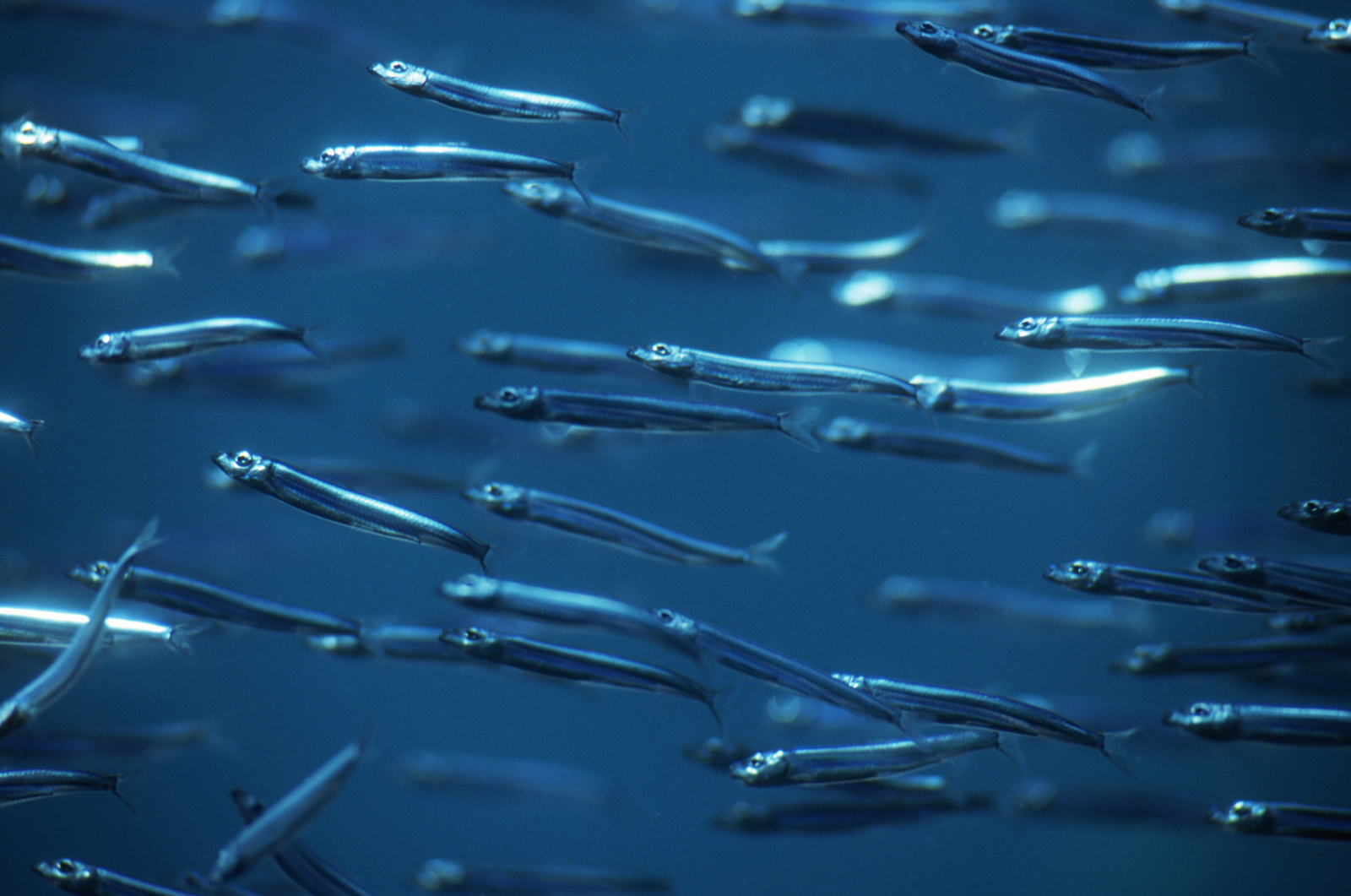
One of the products that has really made a difference to the Spanish fishing fleet is Simrad’s split beam echo sounder that is used when fishing for sardines. This can distinguish between the size of the fish and what type of species they are.
“Sardines must be the right size. If they’re too big or too small, you can’t sell them. We are able to say that currently 100% of the fleet is using our systems to fish in a more effective and sustainable way. Such vessels generally have equipment on board that’s worth EUR 100,000.”
TUNA
The best-equipped fishing vessels are the tuna boats. These are high-speed vessels in which the fishermen generally hunt the strong, fast tuna.
“Tuna vessels can have on-board systems that are worth as much as EUR 1.5 million. They can go through eight tons of fuel per day searching for fish, so for that reason, it is very important to have efficient ways of being able to locate the fish. We sell long-range sonars, advanced echo sounders and navigation sonars”, says Agustin Mayans Fernandez.
Fishing for tuna has been done for a long time now using an FAD—a fish aggregating device. These floating installations resemble trees and other objects that drift in the sea. Lots of small fish gather here, which in turn attracts tuna shoals. The use of artificial FADs is in the process of being banned, so fishermen will need equipment that can localise natural FADs out at sea. Binoculars are currently used, but technology from Kongsberg Defence and Aerospace could be used here.
“We are co-operating with Kongsberg Defence & Airspace on the use of their camera from the Protector Weapon Station—without the weapon of course. We’re going to find out if the camera can be used to localise flocks of birds or “boilers”—the tuna scare the small fish up to the surface of the water so that from a distance it looks like the water is boiling”, says Agustin Mayans Fernandez.

